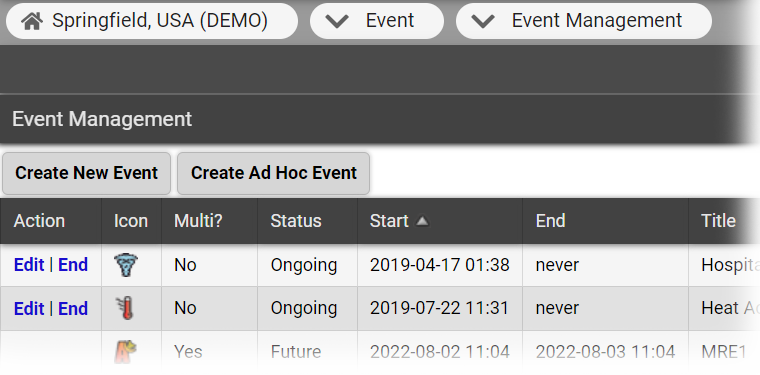Events are situations or activities that are typically episodic in nature. These situations often demand an increase in communications and can include additional status queries. Examples of events include emergencies, such as mass casualty incidents, public health advisories, Amber Alerts, severe weather warnings, supply queries, and bed counts. Events can also be planned, such as drills, exercises, sporting events, and training sessions.
Fields
Events are usually created based on a template, and this is a rights-protected activity that offers multiple configuration options. The following table lists and describes the fields and options available when creating a new or editing an existing event.
| Field | Description |
|---|---|
Title | Name of the event. |
Information | Additional details about the event. |
Event Start | Start date and time for the event; the default is Immediately, but you can set a start date in the future (for example, for exercises and training sessions). |
Event End | Date and time the event is scheduled to end automatically. Alternatively, the event can be open-ended with no specified end date and time. |
Attached File | File containing additional information about the event; file must be a web page (.html), text file (.txt), or PDF (.pdf). Maximum size is 5 MB. |
Display in Event Banner? | Identifies if basic information about the event and a link to the event page appear in a banner near the top of view pages. This option must be selected for events that do not have resources identified. |
Private? | Identifies if the event is only visible for users that are associated with event resources. |
Drill? | Identifies if the event is a drill. |
End Quietly? | Identifies if the event will end without sending notifications to participants and other interested parties. |
Re-notify | Identifies if reminder or follow-up notifications are sent to participants and other interested parties. Disabled by default, but renotification can be set for a specified interval, beginning at a specific date and time, or at specific times during the day. |
Street Address, City, State, Zip Code, County, Latitutde/Longitude | Address where the event is located. Use the Lookup Address and View Map options to help determine locational details. |
Include all resources? | Multi-region events only. Include all resources from all participating regions. |
Select an event template for each participating region | Multi-region events only. Select a template for each participating region. Do not select a template for regions that are not participating. |
Resources to Participate in This Event | Select the check boxes for resources involved in the event. |
PHI Warning
You should not include Protected Health Information (PHI) in EMResource events. When you create or edit an event, a warning about PHI appears at the top of the page. Click the link for more information.
Updates
When changes are made to an event's Title (name) or Information (description), or a resource is added to the event, the word Update precedes the event name in the event bar, along with the number of updates made since the event started. For multi-region events, adding and removing regions to the event are considered updates.
Ad Hoc Events
Authorized users can create ad hoc events to address situations that do not have an appropriate template. When applicable, the Create Ad Hoc Event button appears at the top of the Event Management page. Users with the right to create ad hoc events can also edit and end these events.
The process of creating ad hoc events is like setting up a standard event, except you must select the status types since there is no template specifying these. Prior to creating the ad hoc event, you should create the appropriate status types and associate them with the resource types for the event.
Note: Ad hoc events are based on a regional template provided with EMResource. If you have appropriate rights to manage ad hoc events and event templates, you can edit this template to better accommodate your typical ad hoc events.
Multi-region Events
With the appropriate rights, including the Maintain Events right in every region you want to activate, you can create events that span multiple regions. To do this, every region you include must have a multi-region template that you can select when creating the event.
On the Event Management page, the Create New Multi-Region Event option is only visible if you have the appropriate rights. Creating a multi-region event is like creating a regular event, except you can include all resources in all participating regions or only select resources from each region.
Reported status types are based on those listed in each region's template. Additionally, if location is required in any region's template, it will be required for the multi-region event.


